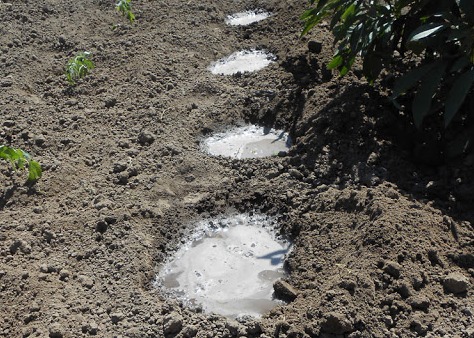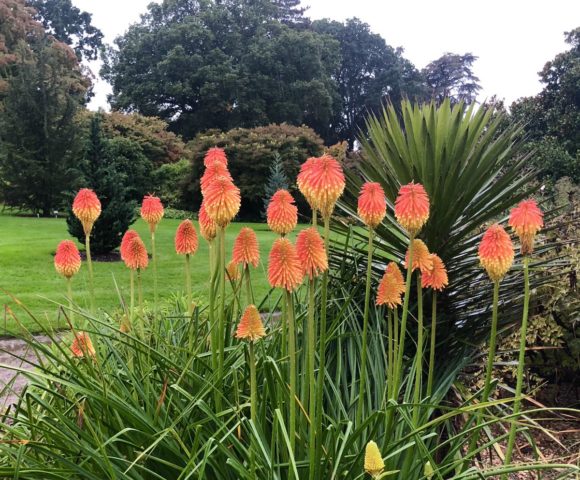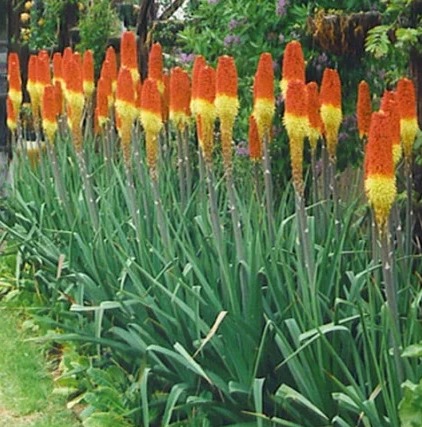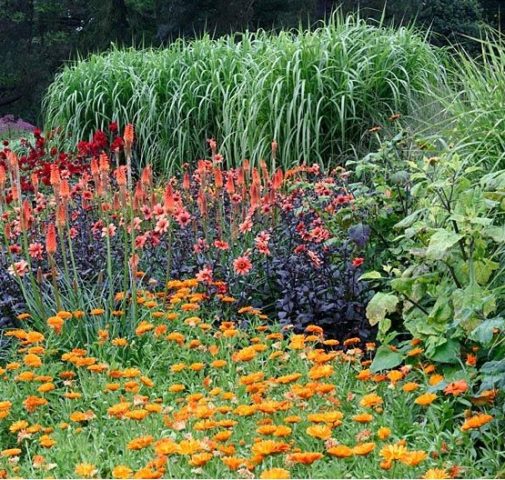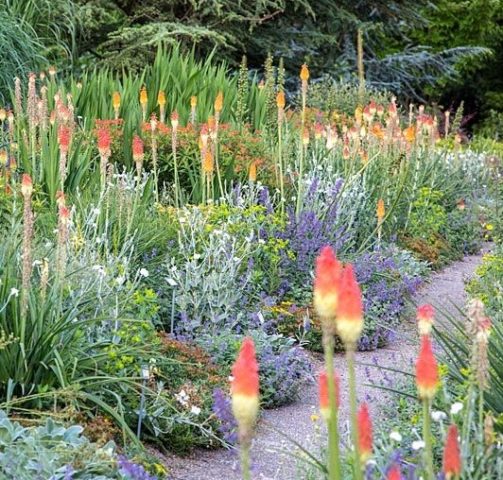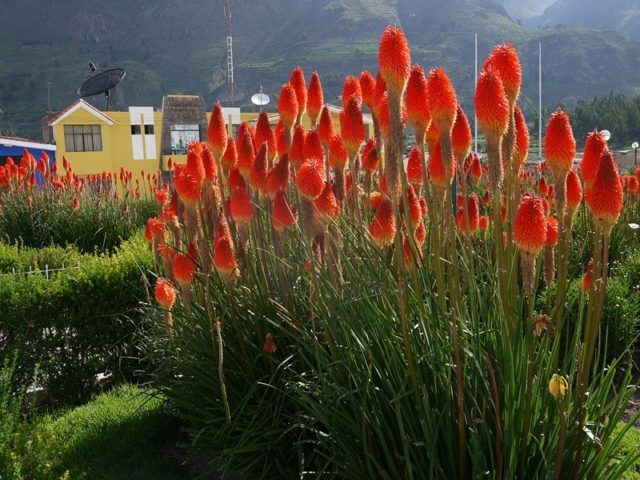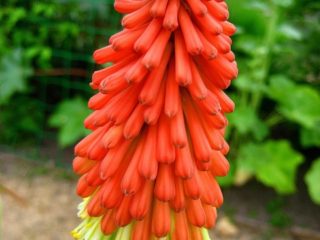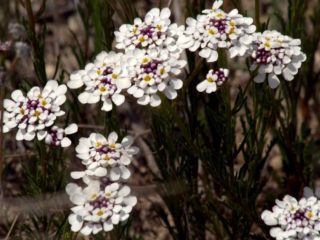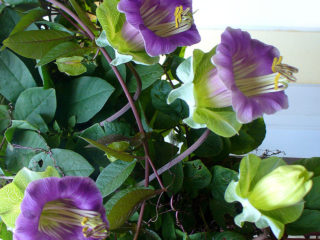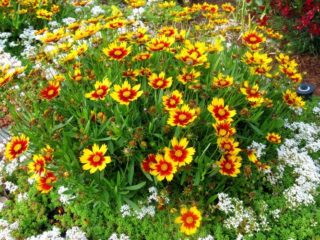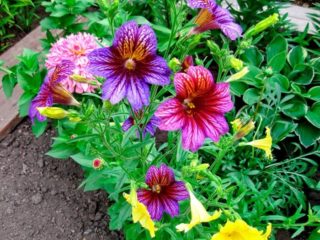Content
Planting and caring for knifophy in the open field in the Russian climate have their own characteristics. In almost all regions, except for the southern ones, the plant is sent for wintering, and returned to the open ground closer to the beginning of June. Despite some peculiarities, knifofia is worth growing. Lush, vibrant, exotic flowers will enliven every corner of the garden. The plant looks original both in single plantings and in composition with other flowers.
The history of the emergence of the flower of knifofia
Kniphofia is a perennial flower belonging to the little-known Asphodelaceae family. In nature, it grows in warm countries of Africa, as well as in Madagascar. The flower was first discovered and described in the 18th century by a German botanist named Johann Kniphof (1704-1763). It was in his honor that the plant got its name.
Also called:
- kniphofia;
- tritoma.
The flower was cultivated rather quickly - already in the 18th century, knifophia began to appear in the gardens of Europe. Gradually, it has spread widely in neighboring countries, including Russia, Turkey, USA, Mexico. It is interesting that in Australia they are trying to get rid of knifophia in every possible way. Thanks to the hot climate, it has confidently taken root on this continent and has become one of the worst weeds, such as buttercups, nettles and many other herbs.
Description and characteristics
The cniphophia flower is a medium-sized perennial herb. It reaches a height of 60-150 cm, and some species (for example, Thomson's knifophia) - even 3 m. The leaves are dense, leathery, very narrow, resembling sabers in shape. The color is saturated green. Due to its dense surface and small area, foliage retains moisture perfectly, so the cniphophy is able to tolerate even prolonged droughts.
The plant stands out for its unusual exotic flowers. They are small, tubular, collected in lush inflorescences-ears (also resemble large cones). They look impressive due to their unusual appearance and large size: they reach 10-25 cm in length. The peduncle of the cniphophia is long, leafless, rounded, with a smooth surface. The flowers are painted in warm shades:
- yellow;
- Orange;
- red;
- coral.
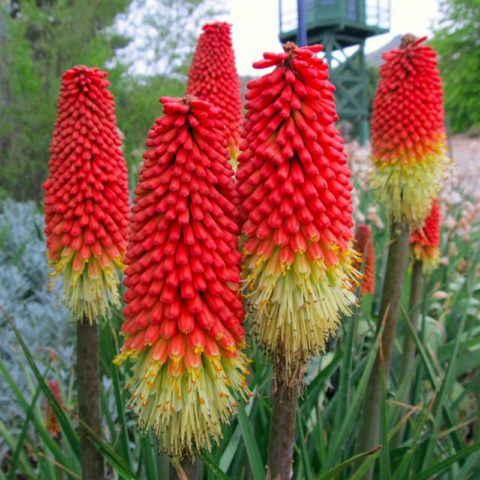
Knifofia blooms mainly in the second half of summer - July and August
The end of flowering is in September. If autumn is warm, inflorescences may appear even in October. At the end of flowering, they form capsule fruits.
Winter hardiness of knifofia
Knifofia comes from warm countries, therefore the plant's winter hardiness is low. Thanks to breeding work, this figure was significantly increased. Almost all types of flowers can withstand temperatures down to -15 ° C. The culture can be bred safely in the southern regions (Kuban, Stavropol, North Caucasus).
In the Moscow region, in the middle lane, in the Urals, in Siberia, in the Far East in the middle of autumn, the bushes of bniphophy must be removed from the soil and sent to winter in a cool room. However, all the work will pay off - the flower looks so original that it will surely become the hallmark of the garden.
Types and varieties of knifophy
There are 75 species in the genus of Bnifofia, and many of them are divided into several varieties. A description of the most popular varieties will help gardeners choose the specimen they like for planting.
Berry knifofia
This type of flower (Kniphofia uvaria) is tall. With proper care, the cniphophy grows up to 180-200 cm. Moreover, the spike-shaped inflorescences are also very large. In length, they reach 25 cm, and the xiphoid leaves - up to 50 cm.The duration of flowering is 2-2.5 months. Within this species, several varieties of bniphophy were bred.
Dr. Kerr
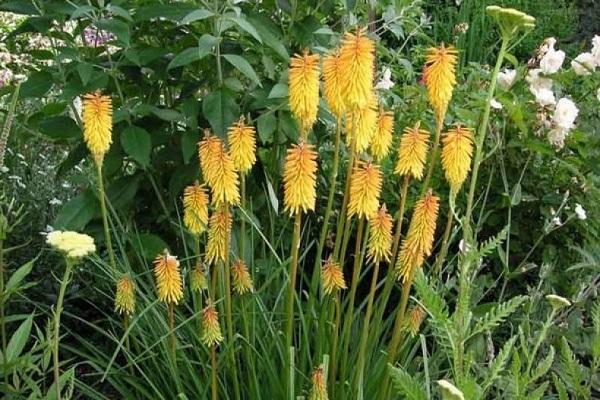
Doctor Kerr variety has rather high peduncles.
The stems of the culture grow up to 1 m in height, while the inflorescences reach 20 cm.The color of the flowers is lemon yellow.
Eskimo
The Popsicke variety usually grows up to 40-50 cm in height. Knifofia is distinguished by moderate winter hardiness - it can withstand frosts down to -22 ° C. The flowers are lemon yellow and coral (depending on the variety).
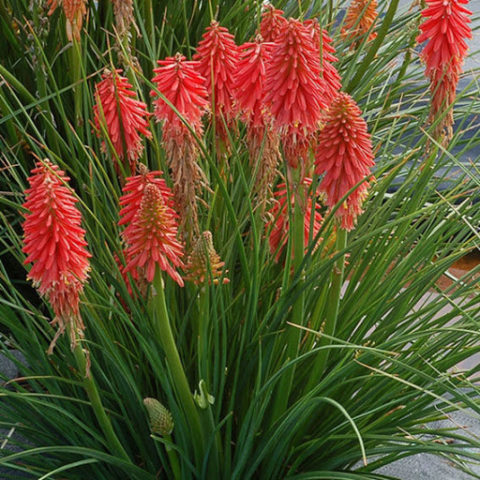
Redhot Popsicle cnifofia features attractive coral flowers
Orange Beauty
Orange Beauty grows up to 100 cm. The variety adorns the garden with very beautiful inflorescences of rich orange color.
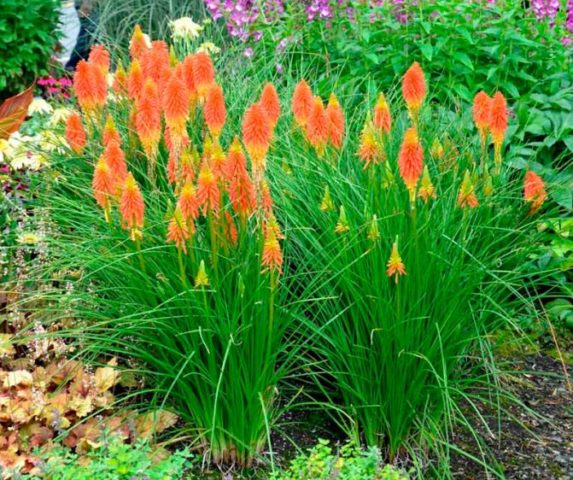
Orange color looks spectacular against a background of bright green foliage
Fire Flame
The Fair Flame variety also produces bright orange flowers that resemble burning torches.
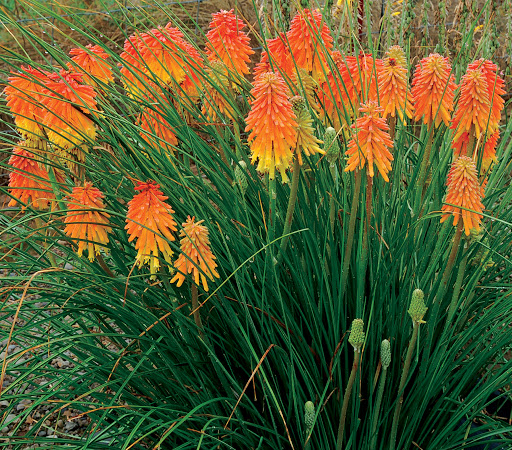
The height of the spike-shaped inflorescences of the Fire Flame variety is 25 cm
The top of the peduncle of the knifofia is fiery red, which makes the culture noticeable in any flower bed.
Large-flowered
The large-flowered form is characterized by very large inflorescences - they reach a height of 20 cm.The height of the peduncles is about 130 cm.

The flowers of this variety of knifofii are also painted in fiery orange shades.
Hybrid knifofia
This group (Kniphofia Hybrida) includes all bred hybrids. Their advantage lies in their good immunity and high resistance to adverse weather conditions. However, the seeds of these plants are sterile, so they must be purchased in stores. The most popular hybrid varieties of knifofia are Cardinal, Golden Skepter, Prince Maurito, Royal Standard, Rocket, Indiana.
Cardinal
The Cardinal variety produces shoots up to 120 cm long. Flowers of a rich red hue are formed on them.
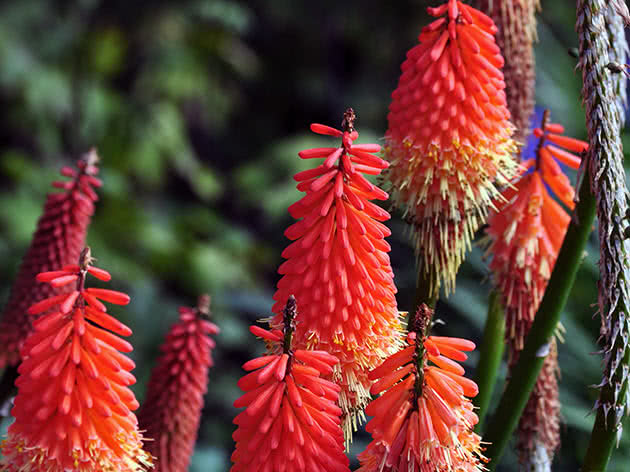
The flowering of the Cardinal variety falls on the warmest summer month (July)
Golden Scepter (Golden Skeeper)
The Golden Scepter knifofia variety is distinguished by good winter hardiness and lush flowering. The color of the flowers is lemon yellow.
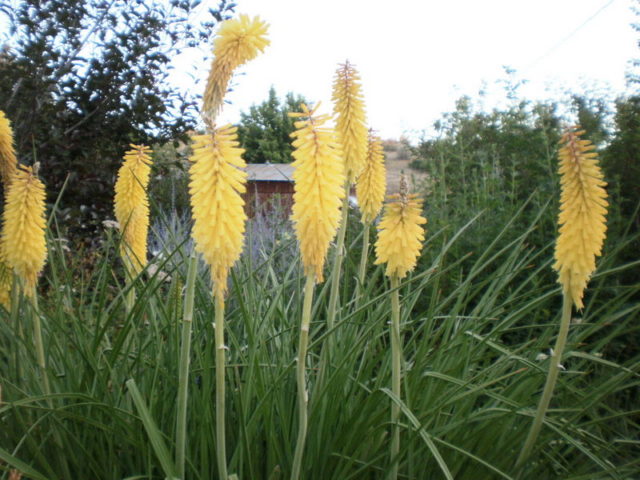
The Golden Scepter variety forms attractive inflorescences of a delicate lemon-yellow color
Prince maurito
The variety Prince Maurito is medium-sized, reaches a height of 120 cm. The flowers are rich in dark red and brownish color.

Prince Maurito blooms in early July
Royal Standard
The variety has been known for a very long time, attracts with beautiful yellow flowers. Peduncle height is 1 m on average.
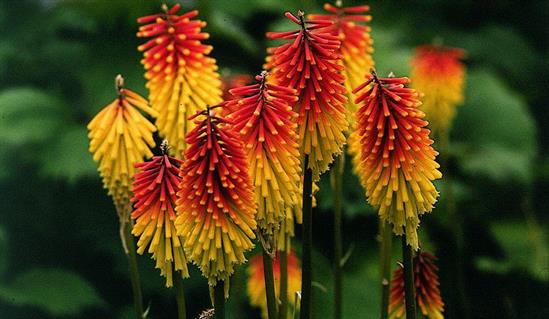
Royal Standard forms reddish-yellow ears of 20-25 cm long
Rocket
The Rocket Knifofia flower variety is a real "rocket" with bright red, crimson flowers growing on a peduncle up to 130 cm high.
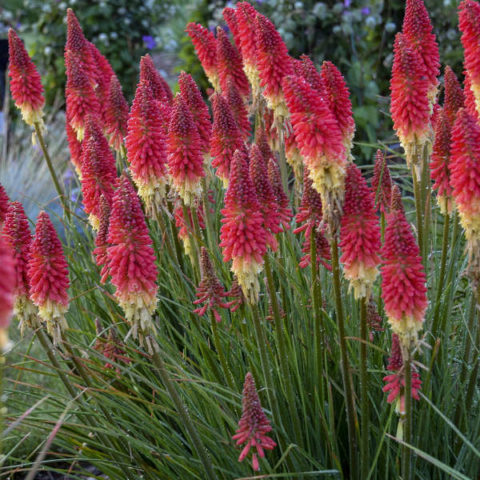
Spectacular yellow-crimson flowers can decorate any mixborder
Indiana
Flower variety cnifofia Indiana - medium-sized (up to 100 cm). Moreover, the flowers are very large, orange and light red.
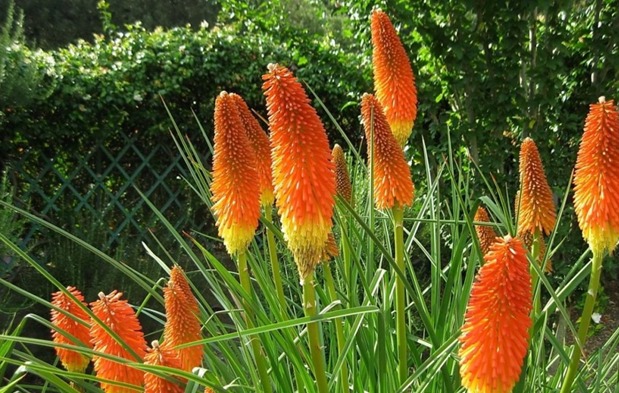
Indiana is considered one of the most beautiful among orange cniphophies.
Knifofia Macowan
The flower kniphofia Kniphofia macowanii is small in size - up to 80 cm in height, inflorescences up to 10 cm. It has been successfully cultivated in the gardens of Europe since the 1870s.
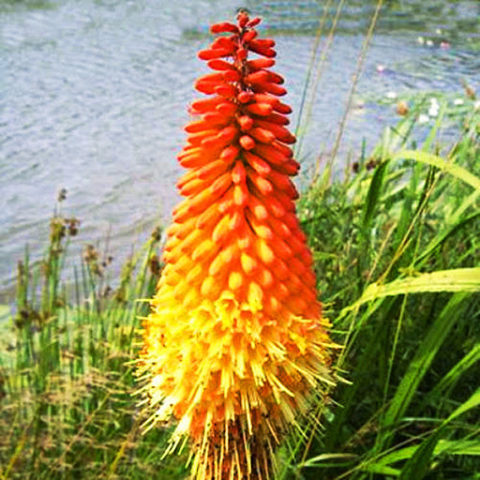
Macowan's range of colors smoothly transitions from bright yellow to rich orange
Knifofia Taka

Kniphofia tuckii, an interesting type of flower of kniphophy, was first discovered by the researcher V. Tuck in 1892.
A low-growing plant (up to 80 cm) with small inflorescences that grow up to 15 cm. It blooms for a month (all July). It is a very showy variety with bright orange-red colors.
Reproduction methods
You can grow knifofia yourself from seeds. In the future, adult bushes can be divided into several divisions and transplanted to a permanent place.
This flower can be propagated in two ways - to grow seedlings from seeds (they do not have time to ripen, so the seed is purchased in the store) or to get a new plant by the vegetative method (by dividing the bush).
Growing Knifofia from seeds at home
It is not very difficult to grow knifophya: the seedlings are looked after in about the same way as in the case of other cultures. First, flower seedlings are obtained in a greenhouse, then they are dived into separate containers. In open ground, seedlings are transferred at the end of June or a little later.
When growing seedlings of a knifofia flower, it is necessary to ensure that the temperature does not drop below room temperature. During the first 2-3 weeks after planting, it should be above 25-27 ° C.
Dividing the bush
The division of the bush of the cniphophia flower begins in late April - early May. Sequencing:
- The bush is dug up.
- The daughter rosettes, which are actively developing from the buds on the mother flower, are carefully separated.
- Flowers are transplanted into new containers (organic matter is added to the soil beforehand).
- In open ground, together with the parent plant, they are transferred closer to July.
Growing and caring for Knifofia
It is not very difficult to grow a knifophia. The main thing is to ensure that the flower grows at temperatures above 20-22 ° C. That is why the culture is transplanted into open ground only in summer.
Sowing and planting dates
It is best to plant the seeds of knifophya during the following periods:
- in the middle lane - at the end of March;
- in the Urals, in Siberia - in early April;
- in the south - in early March.
In this case, you need to be guided by the fact that the flower is transplanted into the open ground after the soil is finally warmed up, i.e. around July (just a few days before flowering). Typically, the planting date for knifofia is:
- in the middle lane - at the end of June;
- in the Urals, in Siberia - at the beginning of July;
- in the south - in early June.
Thus, the seedlings will spend about 2.5-3 months at home. Self-grown knifofia begins to produce flowers in the second or third year.
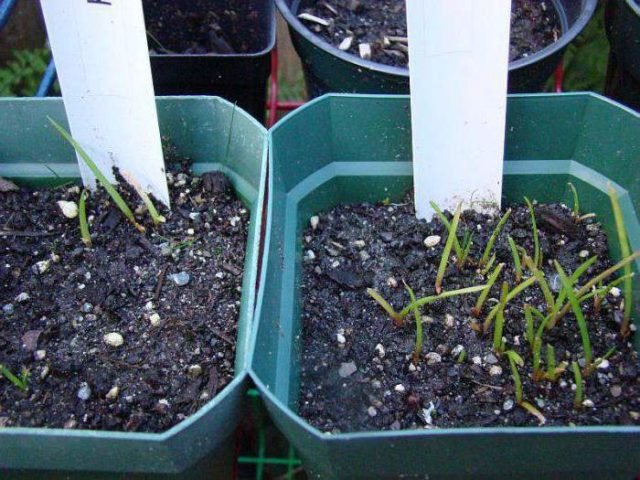
Seedlings begin to grow at the end of March, specific dates depend on the region
Sowing knifofia seeds for seedlings and subsequent care
For planting knifofia, they select any utensils - wooden boxes, plastic containers. You can also plant flowers in pre-moistened peat tablets. This will avoid picking. When growing seedlings of a knifofia flower, you can act according to the following instructions:
- Purchase a universal soil for flower seedlings or compose it yourself on the basis of garden soil, peat, humus and compost in the same ratio. You can add a pinch of wood ash and coarse sand.
- Disinfect the soil and containers by holding them in a solution of potassium permanganate or hydrogen peroxide, then pour water over them.
- Pre-soak the seeds for several hours in a growth stimulant solution (Epin, Kornevin, Zircon).
- Plant them to a depth of no more than 1 cm, with an interval of 3-4 cm.
- Moisten liberally and cover with perforated foil or glass lid.It will create optimal greenhouse conditions.
- Then put the container in a warm place - the temperature is 25-27 degrees. It is advisable to illuminate with a phytolamp so that the duration of daylight hours is 14-15 hours.
- Seedlings appear in 2 weeks, at the same time the film can be removed.
- After the formation of 2-3 leaves, the seedlings of knifofia dive into individual containers. At the same time, the temperature is reduced to 22-23 degrees (slightly above room temperature).
- A week after the picking, the seedlings of knifofia can be fed with complex mineral fertilizer.
- Then it is grown in the same conditions, remembering to water it regularly.
Site and soil preparation
It is quite simple to choose a place for bnifofia:
- The site should be completely open: this flower is used to growing in African hot climates, so it needs maximum light. Even a small shadow is undesirable.
- If possible, the site should be protected from strong winds. It is good if there is a fence, a house or a planting of shrubs not far from the flower.
- Also, the knifophia does not like stagnant moisture, so it is better to plant it on a small hill, and not in a lowland.
Preparing the site is quite simple. It needs to be cleaned and dug up, while breaking all large clods of earth - the knifofia prefers well-loosened soil. If the soil is depleted, it can be fertilized with a complex mineral fertilizer of 50-60 g per 1 m2.
Landing in open ground
The flower planting algorithm is standard:
- In the prepared area, several shallow holes are formed (the rhizomes should be freely placed in them) at a distance of at least 40-60 cm.
- Then a small drainage layer is laid - small pebbles, broken brick, expanded clay or other stones.
- Close up organic matter (2-3 handfuls of humus per hole). If it is not there, you can pour mullein infusion or slurry, or add 1 tbsp. l. potassium salt and superphosphate.
- Root the seedlings, sprinkle with earth, lightly tamp it. In this case, the root collar must be completely buried. If the planting is shallow, it can be affected by sun and wind.
- Water abundantly with warm, previously settled (or rain) water.
- Mulch with peat, hay or other materials at hand.
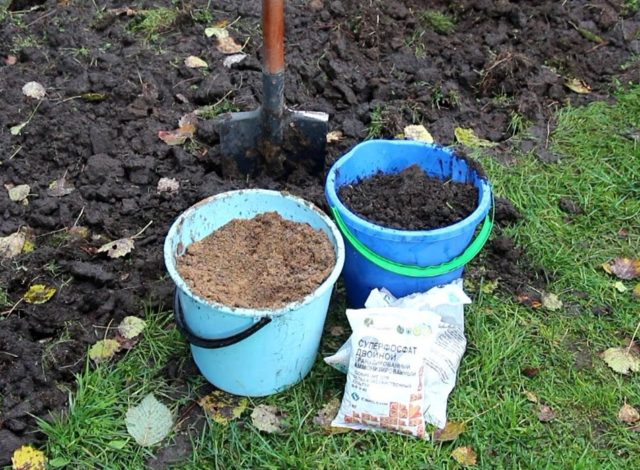
You can immediately add potassium salt and superphosphate to the planting pit
Care, feeding and pruning
Watering should be regular, but at the same time moderate. The top layer of the soil should have time to dry out, remaining barely moist. In drought, the amount of watering can be increased up to 2 times a week. In this case, the water should be at room temperature or slightly warmer. It is optimal to heat it in open containers, in natural conditions (under the sun).
If fertilizers have already been applied when planting a flower of knifofia, the plant does not need additional fertilizing. Starting from the next season, fertilizers are given twice:
- In April - nitrogen-containing (urea or saltpeter).
- After the end of flowering - liquid organic matter or a mixture of potassium salt with superphosphates.
Pruning of knifofia is carried out regularly. The optimal time is early spring. At this time, it is necessary to remove all damaged and weakened shoots, as well as yellowed leaves. The second pruning is carried out after the end of flowering: if the culture is left to winter, all shoots are cut at the root. If it is moved indoors, it is not necessary to do so.
Preparing for winter
Even when growing knifofia in the south, it is advisable to spud and mulch the soil with any available material - peat, dry fallen leaves, straw, hay. The plant does not need special shelters, since the temperature in the Krasnodar Territory and neighboring regions extremely rarely drops below -15 ° C.
In other regions, the flower is dug up in mid-September or early October. It is placed in containers or boxes and put away in a cool room for the winter. It is necessary to maintain a constant temperature in the range of 8-10 ° C.Lighting should be enhanced, preferably illuminated with a phytolamp so that the total length of the day is 10-12 hours (for example, 2 hours in the morning and in the evening). At the beginning of summer, the knifofia is transferred to open ground.
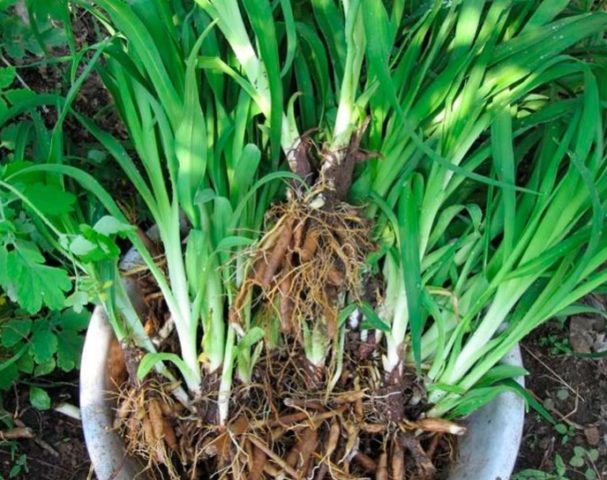
In most regions, knifofia must be moved indoors for the winter, otherwise it will die from frost
Diseases and pests of the Knifofia plant
The flower's immunity is good enough. Subject to the rules of cultivation, knifofia is very rarely sick. However, in the case of excessive watering, root rot is not excluded. Therefore, as a preventive measure, you need to follow the regimen.
Gnawing insects can settle on the flower. In such cases, you should immediately carry out the treatment with insecticides or homemade solutions (infusion of garlic, onion peels, chili peppers, mustard powder, and others).
Knifofia in landscape design
Knifofia looks attractive on any flower bed - both in a single planting and in combination with other ornamental plants. The flower is usually planted in open places, and is also included in different compositions:
- alpine slide, rockery;
- hedge;
- multi-tiered flower bed;
- landing along the track;
- on the coast of the reservoir.
Knifofia always attracts attention, so it is often used in single plantings.
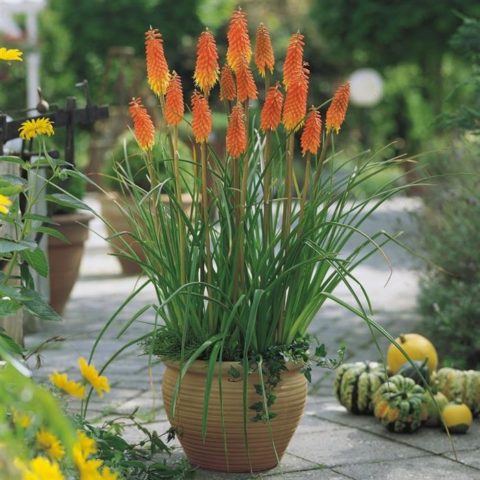
Potted knifofia can become a veranda decoration
Conclusion
Planting and caring for cniphophy in the open field is not very difficult, although they have their own characteristics. The flower literally enlivens the space, bringing an exotic touch and creating an unusual mood.
